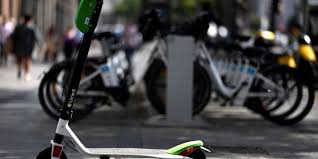Lime Investor Sarah Smith: It’s ‘Inevitable’ That E-Scooters Are Coming to Every Major Market

Another day, another massive e-scooter funding round.
E-scooter startup Lime announced yesterday that it has raised a whopping $ 310 million in Series D funding at a $ 2.4 billion valuation. Bain Capital Ventures, Andreessen Horowitz, Fidelity Ventures, GV, and IVP led the round.
Lime, which began as a bike-share company, has deployed its scooters and bikes in more than 100 cities in the U.S. and 27 international cities. The startup boasts more than 10 million sign-ups and 34 million+ trips.
Lime will use the fresh funding to expand into new markets, improve its technology, and hire more people. “We will also continue investing in two critical areas: rider safety and city collaboration,” reads a Lime blog post.
In light of the news, I spoke with Sarah Smith, the partner at Bain Capital Ventures who co-led the Lime round. Smith joined the firm in May to focus on early-stage investments across consumer technologies and marketplaces. Ironically, her second deal was a Series D round investment.
“I expect the majority of my investments to be Series A, but if I see something unusual, as was the case with Lime, we might pursue something later-stage,” she told Term Sheet.
I spoke with Smith about the Lime investment, scooter regulation, and the future of transportation.
FORTUNE: Out of all the players in the e-scooter space, why did you decide to invest in Lime?
SMITH: Over 2018, it was clear there was this almost vertical consumer demand curve happening with adoption of scooters and e-bikes. If you look at the ridership and usage, it is the fastest consumer adoption of any technology I’ve ever seen.
So late last year, we asked ourselves, “Is this something we would even consider?” Because it’s pretty outside the scope of traditional things that Bain has done. We did a deep dive into the industry, and met nearly every player in the micro-mobility space in a matter of several weeks. Once we had a point of view on what mattered, we decided whether it’s something that’s investable right now in a time horizon that makes sense. It became obvious to us that Lime was the clear winner for us from an investing standpoint.
Can you explain why?
SMITH: There are a few key things we think about when looking at a company like this. Certainly a lot of people focus on hardware and supply chain, and while we think that’s important for safety and the longevity of the vehicle, we believe that you have to assume that at some point most companies at any scale will get to parity in terms of their capabilities. That said, Lime certainly has a strong supply chain capability internally, and we felt we were ahead from most players on hardware. But that’s not the crux of the thesis on why we chose to invest.
Another area to look at is around utilization, which is how many trips per vehicle per day can you get? So you have this vehicle sitting in the middle of Atlanta, and you ask yourself: How can I get the most trips per day because that’s where the most of my revenue will come from.
What you really have to have is a really strong set of data to help you determine where you should be placing this vehicle in the morning and throughout the day. Do you need to re-balance them? How can you create incentives within your network of local contractors who can help re-balance the location of those scooters? Interestingly, 40% of trips come from or to a public transit station, which makes sense, because it’s the last mile. So how do you take advantage of that and make sure that you don’t have a vehicle stuck in a dead zone for too long? If you have the most experience, the most markets, the most data — you will be better equipped to run a large-scale operation effectively in many different types of markets.
The other interesting component of this is government regulation. This type of solution could really alleviate a lot of traffic congestion, but the challenge for cities is managing vendors, managing safety, and making sure the scooters are being parked in the right place. Governments can do everything from having a “hard cap” and say you can only have 500 scooters per vendors. They can do no cap, which could mean a flooding of the streets. Or they can do “dynamic capping,” which is where we believe the industry is going. We think most cities will have three to six vendors, and the way to regulate how many vehicles to have on the road is through dynamic capping. They’ll watch the trip per vehicle per day on average per vendor, and if it dips below a certain amount, they’ll make them pull them back.
In that way, cities and operators can better manage the marketplace to make sure there are enough scooters for consumers and that they are in the right places at the right times. When we called municipalities, they had really positive feedback about Lime and how they had worked with cities to shape these policies, and that gave us a lot of confidence to invest.
Why not invest in rival scooter startup Bird?
SMITH: There’s a lot of things Bird has done well for sure, and we like the team there too, but when we looked at a number of different factors that were important, it was clear to us that it had to be Lime. Scale matters, and Lime by far has the most distribution in the most markets. We also felt really good about how they were managing their supply chain and their pace of development and hardware improvements. And the executive team is just really robust and world-class.
When ride-sharing emerged, pioneers like Uber took an aggressive approach with cities. Some scooter companies have attempted a similar strategy, but a number of municipalities have cracked down with restrictions and bans. Will the ride-sharing approach work in this sector?
SMITH: Certainly it’s different in that it’s a physical piece of hardware sitting on the street, so unlike a driver turning off the app, a city could literally impound the scooter. Because of that, it has to be a very different type of relationship. With that said, I think both industry players and municipalities have learned a lot from ride-sharing over the last number of years. It’s a big reason why Lime has been proactive in working with cities first to try and help shape the policies because this is something that will take a lot of cooperation between the city officials and the operators.
I do think it has to be a city-first approach, but at the end of the day, it feels inevitable that every major market will have scooters because cities feel pressured from constituents to figure it out.
But do you think it’s realistic to expect cities that don’t have the proper infrastructure to support scooters in a meaningful way?
SMITH: They may not have dedicated bike lanes, but most cities do have at least some paths where bicycles are being used. Anywhere a bike could go successfully, a scooter can go successfully.
What is the next evolution of scooter safety measures other than helmets that few riders even wear?
SMITH: There are a lot of safety measures being put in place around what speed limits will be allowed for the scooters. There are a lot of things that can be done over time with the GPS on the vehicle. For example, it can detect if the vehicle is getting too far away from the dedicated zone or if there is erratic behavior and someone is unfit to ride it. Having better waterproofing of the vehicle will also help in the long-term too. Of course, some of it will be dependent on the city and the local conditions that are set up.
And what about seasonality? Scooters are great in California, but what happens on the East Coast where we have a polar vortex every other week?
SMITH: We certainly see a dip in usage because of seasonality. What’s interesting is that it looks like precipitation is actually more of a damper to usage than temperature. If you think about it, if it’s really cold outside, you’d rather get somewhere faster than walking slowly. If I’m in windy Chicago and I could get somewhere five minutes faster, I’d do that. But rain and snow are actually bigger factors than temperature.
Here’s the thing: Scooters have literally been on the road for less than a year. We are now only getting through our first winter, and if you think about product development in general, this is V1 of winter. We’ve learned a lot this winter that will probably make us dramatically better during next year’s winter.
Uber invested in Lime and added the scooters as an option on its app in effort to compete with Bird. Is Lime a potential acquisition target for Uber?
SMITH: Given the fact that Uber and Lyft and others know that a significant portion of their rides are in this last-mile category, they are already doing active work in the space. I think there’s advantages in being in Lime’s position where they own the supply chain and they have the opportunity to have multiple types of e-vehicles.
Running a business like Lime is very different than running a marketplace like Uber or Lyft. I think a lot of people associate them because they’re all in transportation, but the fundamental thing you own and manage is very different. I think it will be an advantage for Lime to continue to build a big business on their own, but yes, certainly we expect that Uber, Lyft, and others will jump in and get involved over time too.
What is the biggest risk you foresee in the micro-mobility space?
SMITH: There’s no question in my mind that it’s inevitable, so I don’t think it’s a risk of “does this exist?” But I think there are risks around some cities not having the infrastructure to support them properly such that it becomes a sort of mixed experience for the consumer. If that’s the case, some consumers get a lot of benefits while others don’t. If people aren’t parking them properly, they can get in the way of someone in a wheelchair, for example. It’s really important that they are properly set up and the rules are properly enforced just to make sure you have a successful experience possible for all consumers.
I do think cities that do fixed capping of scooters really run the risk of deterring adoption because it typically means there are fewer vehicles on the road that would be optimal for the demand. So what happens is consumers walk out, never see a scooter, and think, “Why would I ever use it if it’s never there?” You really need to have enough density.
What do you think transportation looks like 10 years from now?
SMITH: I think we’re going to be in a much more streamlined, multi-modal world. I think we will be able to have apps and services that stitch together to get you from Point A to Point B in the fastest, most fuel-efficient, environmentally-friendly way possible. Every minute of every day, I should be able to open an app and know exactly which modes of transportation I’d be taking.
In 10 years, it’s not crazy to think that most 16-year-olds will not be getting their driver’s licenses. It’ll be like riding a horse — some people will continue to do it, but most people will never need to learn. If you live in a remote area — similar to if you live somewhere where it makes sense for you to learn how to ride a horse — then you would do that. But if you live anywhere with any kind of urban density — even the suburbs — you probably will not need to learn how to drive the car. It’ll all be autonomous vehicles, which is fantastic because it opens up the world to a whole lot of people who can’t be mobile right now because of the simple fact that they can’t drive.










